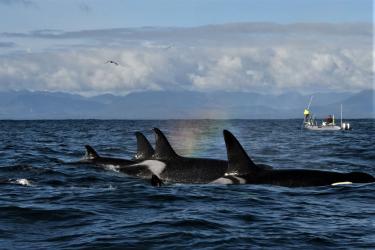Ensuring the sustainability of our nation’s fisheries—and the millions of jobs and billions of dollars in sales they support—requires a clear understanding of when, where, and how fishermen are operating, and monitoring what they catch, keep, and discard. Gathering this information has historically relied upon a combination of fishery observers, vessel monitoring systems (VMS), landings reports, and self-reported paper logbooks from captains and seafood processors and dealers. NOAA Fisheries and our partners are exploring how technologies like electronic reporting (ER), electronic monitoring (EM), and other tools can help meet the ever-increasing need to improve the timeliness, accuracy, and cost-effectiveness of collecting and processing fishery-dependent data.
Electronic Monitoring
Electronic monitoring uses equipment like video cameras, GPS receivers and transmitters, and gear sensors to capture information on fishing location, hours or days spent fishing, catch, and discards. This equipment can also track compliance with catch retention requirements and, in certain fisheries, interactions with protected species such as turtles, marine mammals, and birds.
Electronic Reporting
Electronic reporting uses smartphones, tablets, computers, and other technologies to record, store, and securely transmit fishery-dependent data. Along with our partners, we are moving away from paper forms and expanding ER tools to collect different types of data, such as:
- Landings, discard, and other fishing information reported by fishermen.
- Commercial landings and purchase data reported by dealers, tenders, and seafood processors.
- Data collected by at-sea fishery observers.
Vessel Monitoring System Program (VMS)
The VMS program tracks vessel location and movement information that is used to ensure compliance with closed area regulations, monitor fishing quotas, validate other data sources, and provide notification of port arrivals so that shoreside observers can meet vessels to conduct biological sampling and collect other data.
Recently, NOAA Fisheries published updated national requirements to allow cellular-based VMS systems that can capture the same data at a fraction of the cost of satellite-based systems.
Leveraging Artificial Intelligence for Electronic Monitoring
Fisheries have historically relied upon labor-intensive data processing and analysis, such as monitoring real-time VMS data, manually reviewing images collected by EM systems, and implementing complex procedures for integrating data collected from different programs. Artificial intelligence (AI) and machine learning applications exist in almost all of society (e.g., self-driving cars, social media, health care). More recently these tools are being developed for the marine sciences by NOAA Fisheries and our non-governmental partnerships to conduct underwater surveys (e.g., for habitat, coral, fish) and aerial surveys (e.g., for marine mammals), and similar AI applications can be used to predict where and when fishing may occur. For EM programs, AI can be used to automatically process video, which would vastly improve the cost-effectiveness and timeliness of EM data analysis.
ET Policy Directive and Implementation Plans
NOAA Fisheries established an Electronic Technologies Policy Directive in 2013 to provide guidance on the adoption of electronic technology solutions in fishery-dependent data collection programs. From this policy directive, each region developed an ET implementation plan in 2015. The ET policy directive was updated in 2019 to include guidance for updating regional ET implementation plans, which cover 2021 - 2025. The new ET implementation plans are now available; they’ll be updated and republished each spring.
Regional Resources
Electronic technologies for fisheries data collection are primarily developed and implemented at the regional level in partnership with fishery management councils, the fishing industry, and other partners. Learn more about what’s happening in each region:



